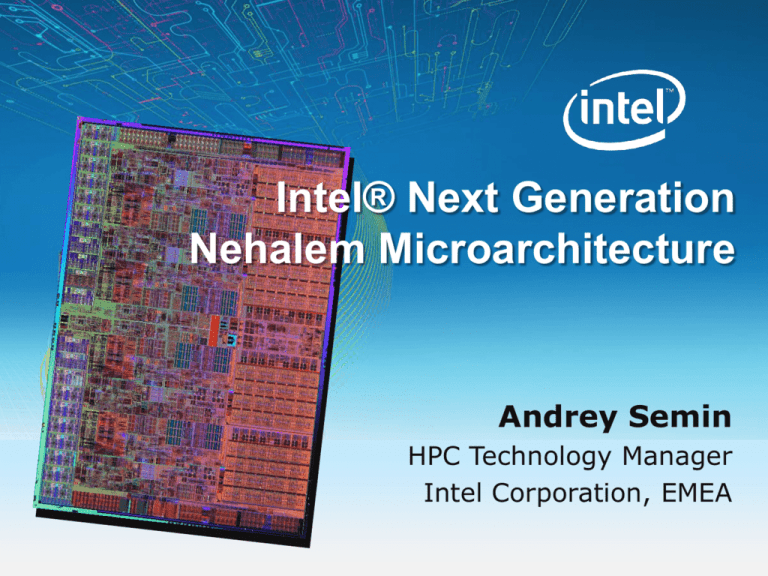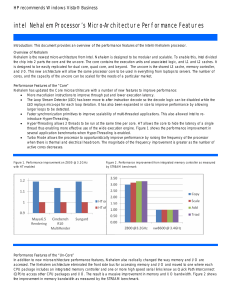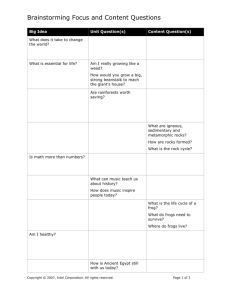Intel® Next Generation Nehalem Microarchitecture
advertisement

Intel® Next Generation
Nehalem Microarchitecture
Andrey Semin
HPC Technology Manager
Intel Corporation, EMEA
© 2007 Intel Corporation
Agenda
•
•
•
•
•
Nehalem Design Philosophy
Enhanced Processor Core
New Instructions
Optimization Guidelines and Software Tools
New Platform Features
All products, dates, and figures specified are preliminary based on current expectations, and are subject to change without notice.
Intel, processors, chipsets, and desktop boards may contain design defects or errors known as errata, which may cause the product to deviate from published specifications. Current
characterized errata are available on request.
Penryn, Nehalem, Westmere, Sandy Bridge and other code names featured are used internally within Intel to identify products that are in development and not yet publicly
announced for release. Customers, licensees and other third parties are not authorized by Intel to use code names in advertising, promotion or marketing of any product or services
and any such use of Intel's internal code names is at the sole risk of the user
Performance tests and ratings are measured using specific computer systems and/or components and reflect the approximate performance of Intel products as measured by those
tests. Any difference in system hardware or software design or configuration may affect actual performance.
Intel, Intel Inside, Xeon, Core, Pentium, AVX and the Intel logo are trademarks of Intel Corporation in the United States and other countries.
*Other names and brands may be claimed as the property of others.
Copyright © 2009 Intel Corporation.
2
Intel Tick-Tock Development Model:
Delivering Leadership Multi-Core Performance
Presler · Yonah · Dempsey
65nm
Processor Performance
New Microarchitecture
Intel® Core™ Microarchitecture
16.0
Shrink/Derivative
Penryn Family
45nm
New Microarchitecture
Nehalem
Shrink/Derivative
Westmere
New Microarchitecture
Sandy Bridge
“Tick
(Shrink)
Tock”
(Innovate)
32nm
Performance Ratio - 2005 baseline
2 YEARS
2 YEARS
2 YEARS
Shrink/Derivative
Sandy Bridge
14.0
12.0
Westmere
10.0
8.0
6.0
Nehalem
Core QC
Penryn
4.0
Core DC
2.0
0.0
Netburst
Source: Intel
2005
Future
Silicon and Software Tools Unleash Performance
3
Nehalem: Scalable Cores
Same core for
all segments
Common software
optimization
Nehalem
Common feature set
Servers/Workstations
45nm
Energy Efficiency,
Performance, Virtualization,
Reliability, Capacity, Scalability
Desktop
Performance, Graphics, Energy
Efficiency, Idle Power, Security
Mobile
Battery Life, Performance,
Energy Efficiency, Graphics,
Security
Optimized cores to meet all market segments
4
Core Microarchitecture Recap
Wide Dynamic Execution
-
4-wide decode/rename/retire
Advanced Digital Media Boost
-
128-bit wide SSE execution units
Intel HD Boost
-
New SSE4.1 Instructions
Smart Memory Access
-
Memory Disambiguation
Hardware Prefetching
Advanced Smart Cache
-
Low latency, high BW shared L2 cache
Nehalem builds on the great Core microarchitecture
5
Nehalem Micro-Architecture
A new dynamically scalable microarchitecture
KEY FEATURES
BENEFITS
45nm Intel® multi-core processors
Energy efficient multi-core processing
(2, 4, 8 core implementations planned)
Greater Instruction per clock and
improved cache hierarchy
Faster Processing / core
Simultaneous Multi-Threading
More Threads / core
Dynamic Resource Scaling
Lower power consumption during periods
of low utilization
Any unneeded cores automatically put into sleep mode;
remaining operating cores get access to ALL cache,
bandwidth and power/thermal budgets
Turbo Mode
Additional Processing boost during peak
demand periods
CPU operates at higher-than-stated frequency when
operating below power and thermal design points
FASTER cores … MORE cores/threads … DYNAMICALLY ADAPTABLE
Source: Intel. All future products, computer systems, dates, and figures specified are preliminary based
on current expectations, and are subject to change without notice.
6
Agenda
•
•
•
•
•
Nehalem Design Philosophy
Enhanced Processor Core
New Instructions
Optimization Guidelines and Software Tools
New Platform Features
7
Designed for Performance
New SSE4.2
Instructions
Improved Lock
Support
L1 Data Cache
Execution
Units
Deeper
Buffers
Out-of-Order
Scheduling &
Retirement
Simultaneous
Multi-Threading
Memory Ordering
& Execution
Instruction
Decode &
Microcode
Faster
Virtualization
8
Additional Caching
Hierarchy
L2 Cache
& Interrupt
Servicing
Paging
Branch Prediction
Improved
Loop
Streaming
Instruction Fetch
& L1 Cache
Better Branch
Prediction
Enhanced Processor Core
Instruction Fetch and
Pre Decode
ITLB
32kB
Instruction Cache
Instruction Queue
Front End
Execution
Engine
Memory
Decode
4
2nd Level TLB
Rename/Allocate
Retirement Unit
(ReOrder Buffer)
2nd
4
Reservation Station
6
Execution Units
DTLB
32kB
Data Cache
9
256kB
Level Cache
L3 and beyond
Front-end: Loop Stream Detector
Reminder
Loops are very common in most software
Take advantage of knowledge of loops in HW
-
Decoding the same instructions over and over
Making the same branch predictions over and over
-
Stream from Loop Stream Detector instead of normal path
Disable unneeded blocks of logic for power savings
Higher performance by removing instruction fetch limitations
Loop Stream Detector identifies software loops
Core 2 Loop Stream Detector
Branch
Prediction
Loop
Fetch
Stream
Detector
18
Instructions
10
Decode
Front-end: Loop Stream Detector
in Nehalem
Same concept as in prior implementations
Higher performance: Expand the size of the
loops detected
Improved power efficiency: Disable even more
logic
Nehalem Loop Stream Detector
Branch
Prediction
Fetch
Decode
Loop
Stream
Detector
28
Micro-Ops
11
Execution Engine
Start with powerful Core 2 execution engine
-
-
Dynamic 4-wide Execution
Advanced Digital Media Boost
128-bit wide SSE
HD Boost (Penryn)
SSE4.1 instructions
Super Shuffler (Penryn)
Add Nehalem enhancements
-
Additional parallelism for higher performance
12
Execution Unit Overview
Unified Reservation Station
• Schedules operations to Execution units
• Single Scheduler for all Execution Units
• Can be used by all integer, all FP, etc.
Execute 6 operations/cycle
• 3 Memory Operations
• 1 Load
• 1 Store Address
• 1 Store Data
• 3 “Computational” Operations
Unified Reservation Station
FP Multiply
FP Add
Divide
Complex
SSE Integer ALU
SSE Integer
Integer Shuffles
Multiply
Port 5
LEA
Load
Port 4
Shift
Port 3
Integer ALU &
Port 2
Port 1
Port 0
Integer ALU &
Store
Store
Integer ALU &
Address
Data
Shift
Branch
FP Shuffle
Integer
SSE Integer ALU
Integer Shuffles
13
Increased Parallelism
Concurrent uOps Possible
Goal: Keep powerful
execution engine fed
Nehalem increases size of
out of order window by 33%
Must also increase other
corresponding structures
128
112
96
80
64
48
32
16
0
Dothan
Merom
Nehalem
Structure
Merom
Nehalem
Comment
Reservation Station
32
36
Dispatches operations
to execution units
Load Buffers
32
48
Tracks all load
operations allocated
Store Buffers
20
32
Tracks all store
operations allocated
Increased Resources for Higher Performance
14
Enhanced Cache Subsystem –
New Memory Hierarchy
New 3-level cache hierarchy
-
-
1st level remains the same as Intel
Core Microarchitecture
32KB instruction cache
32KB data cache
256 KB per core – holds data +
instructions
Very low latency
Large size (8MB for 4-core)
Shared between all cores
L1
L1
L1
L1
I-cache
I-cache
I-cache
I-cache
L1
L1
L1
L1
D-Cache
D-Cache
D-Cache
D-Cache
L2
Cache
L2
Cache
L2
Cache
L2
Cache
New L2 cache per core
New shared last level cache
Last Level Cache
Allows lightly threaded applications to
use the entire cache
Inclusive Cache Policy
Minimize traffic from snoops
On cache miss, only check other
cores if needed (data in modified
state)
15
Faster Synchronization Primitives
Multi-threaded software
becoming more prevalent
Scalability of multi-thread
applications can be limited
by synchronization
Synchronization primitives:
LOCK prefix, XCHG
Reduce synchronization
latency for legacy software
Relative Latency
LOCK CMPXCHG Perform ance
1
0.9
0.8
0.7
0.6
0.5
0.4
0.3
0.2
0.1
0
Pentium 4
Core 2
Nehalem
Greater thread scalability with Nehalem
16
Other Performance Enhancements
Intel Xeon® 5500 Series Processor (Nehalem-EP)
Intel® Turbo Boost
Technology
Intel® Hyper-Threading
Technology
Increases performance by increasing
processor frequency and enabling faster
speeds when conditions allow
Increases performance for threaded
applications delivering greater
throughput and responsiveness
Core 1
<4C Turbo
Core 0
Core 3
Core 2
Core 1
Core 0
4C Turbo
Core 3
Core 2
Core 1
Core 0
Frequency
Normal
Up to 30% higher†
All cores
operate at
rated
frequency
All cores
operate
at higher
frequency
Fewer cores
may operate at
even higher
frequencies
Higher performance
for threaded workloads
Higher performance
on demand
†
For notes and disclaimers, see performance and legal information slides at end of this presentation.
17
Hyper-Threading Implementation
Details for Nehalem
Multiple policies possible for implementation of SMT
Replicated – Duplicate state for SMT
-
Register state
Renamed RSB
Large page ITLB
-
Key buffers: Load, store, Reorder
Small page ITLB
-
Reservation station
Caches
Data TLBs, 2nd level TLB
-
Execution units
Partitioned – Statically allocated between threads
Competitively shared – Depends on thread‟s dynamic behavior
Unaware
18
Agenda
•
•
•
•
•
Nehalem Design Philosophy
Enhanced Processor Core
New Instructions
Optimization Guidelines and Software Tools
New Platform Features
19
Extending Performance and Energy Efficiency
- SSE4.2 Instruction Set Architecture (ISA) Leadership
Accelerated
String and Text
Processing
Faster XML parsing
Faster search and pattern
matching
Novel parallel data
matching and comparison
operations
Accelerated Searching
& Pattern Recognition
of Large Data Sets
Improved performance for
Genome Mining,
Handwriting recognition.
Fast Hamming distance /
Population count
New Communications
Capabilities
Hardware based CRC
instruction
Accelerated Network
attached storage
Improved power efficiency
for Software I-SCSI, RDMA,
and SCTP
SSE4
STTNI
(45nm CPUs)
SSE4.1
(Penryn Core)
ATA
SSE4.2
(Nehalem Core)
STTNI
e.g. XML
acceleration
ATA
(Application
Targeted
Accelerators)
POPCNT
e.g. Genome
Mining
What should the applications, OS and VMM vendors do?:
Understand the benefits & take advantage of new instructions in 2008.
Provide us feedback on instructions ISV would like to see for
next generation of applications
20
CRC32
e.g. iSCSI
Application
STTNI - STring & Text New Instructions
Operates on strings of bytes or words (16b)
Equal Each Instruction
True for each character in Src2 if
same position in Src1 is equal
Src1:
Test\tday
Src2:
tad tseT
Mask:
01101111
STTNI MODEL
Source2 (XMM / M128)
Equal Any Instruction
Ranges Instruction
True for each character in Src2
if any character in Src1 matches
Src1:
Example\n
Src2:
atad tsT
Mask:
10100000
True if a character in Src2 is in
at least one of up to 8 ranges
in Src1
Src1:
AZ’0’9zzz
Src2:
taD tseT
Mask:
00100001
Equal Ordered Instruction
Finds the start of a substring (Src1)
within another string (Src2)
Src1:
ABCA0XYZ
Src2:
S0BACBAB
Mask:
00000010
Source1 (XMM)
Bit 0
T
e
s
t
\t
d
a
y
t ad t s eT
xxxxxxxT
xxxxxxTx
xxxxxTxx
xxxxTxxx
xxxFxxxx
xxTxxxxx
xTxxxxxx
Fxxxxxxx
01101111
Projected 3.8x kernel speedup on XML parsing &
2.7x savings on21instruction cycles
Bit 0
Check
each bit
in the
diagonal
IntRes1
STTNI Model
EQUAL EACH
EQUAL ANY
Source2 (XMM / M128)
Source1 (XMM)
Bit 0
E
x
a
m
p
l
e
\n
a
F
F
T
F
F
F
F
F
t ad
FFFF
FFFF
FTFF
FFFF
FFFF
FFFF
FFFF
FFFF
t
F
F
F
F
F
F
F
F
sT
FF
FF
FF
FF
FF
FF
FF
FF
Bit 0
OR results down
each column
Bit 0
Source1 (XMM)
Source2 (XMM / M128)
10100000
T
e
s
t
\t
d
a
y
IntRes1
RANGES
t aD t s e T
A FFTFFFTT
Z FFTTFFFT
„0‟ T T T F T T T T
9 FFFTFFFF
z FFFFFFFF
z TTTTTTTT
z FFFFFFFF
z TTTTTTTT
00100001
Check
each bit in
the
diagonal
IntRes1
Source2 (XMM / M128)
Bit 0
S0BACBAB
Bit 0
•First Compare
does GE, next
does LE
Bit 0
•AND GE/LE pairs of results
•OR those results
IntRes1
22
Source1 (XMM)
Source1 (XMM)
Bit 0
Bit 0
EQUAL ORDERED
Source1 (XMM)
Source2 (XMM / M128)
t ad t seT
xxxxxxxT
xxxxxxTx
xxxxxTxx
xxxxTxxx
xxxFxxxx
xxTxxxxx
xTxxxxxx
Fxxxxxxx
01101111
A
B
C
A
0
X
Y
Z
fF fF F T F
fF fF T F F
fF fF F F T
fF fF F T F
fTfTfTfT x
fTfTfT x x
fTfT x x x
F
T
F
x
x
x
x
T
F
x
x
x
x
x
F
x
x
x
x
x
x
fT x x x x x x x
00000010
Bit 0
AND the results
AND the along
results
each
along each
diagonal
diagonal
IntRes1
Example Code For strlen()
string equ
[esp + 4]
mov
ecx,string
; ecx -> string
short
test ecx,3
; test if string isjealigned
onbyte_2
32 bits
test eax,0ff000000h
je
short main_loop
; is it byte 3
str_misaligned:
je
short byte_3
; simple byte loop until string is aligned
jmp
short main_loop
mov
al,byte ptr [ecx]
; taken if bits 24-30 are clear and bit
add
ecx,1
; 31 is set
test al,al
byte_3:
je
short byte_3
lea
eax,[ecx - 1]
test ecx,3
mov ecx,string
jne
short str_misaligned
sub
add
eax,dword ptr 0
; 5 byte nop to
aligneax,ecx
label below
ret
align 16
; should be redundant
byte_2:
main_loop:
lea
eax,[ecx - 2]
mov
eax,dword ptr [ecx]
; read 4 bytes
mov
ecx,string
mov
edx,7efefeffh
sub
eax,ecx
add
edx,eax
ret
xor
eax,-1
byte_1:
xor
eax,edx
lea
eax,[ecx - 3]
add
ecx,4
mov
ecx,string
test eax,81010100h
sub
eax,ecx
je
short main_loop
ret
; found zero byte in the loop
byte_0:
mov
eax,[ecx - 4]
lea
eax,[ecx - 4]
test al,al
; is it byte 0
mov
ecx,string
je
short byte_0
sub
eax,ecx
test ah,ah
; is it byte 1
ret
je
short byte_1
test eax,00ff0000h ; is it byte 2 strlen endp
end
STTNI Version
int sttni_strlen(const char * src)
{
char eom_vals[32] = {1, 255, 0};
__asm{
mov
eax, src
movdqu
xor
xmm2, eom_vals
ecx, ecx
topofloop:
add
eax, ecx
movdqu
xmm1, OWORD PTR[eax]
pcmpistri
xmm2, xmm1, imm8
jnz
topofloop
endofstring:
add
eax, ecx
sub
ret
eax, src
}
}
Current Code: Minimum of 11 instructions; Inner loop processes
4 bytes with 8 instructions
STTNI Code: Minimum of 10 instructions; A single inner loop processes 16 bytes with only 4
instructions
23
ATA - Application Targeted Accelerators
CRC32
POPCNT
POPCNT determines the number of nonzero
Accumulates a CRC32 value using the iSCSI polynomial
bits in the source.
63
DST
SRC
32 31
X
63
0
10
0 1 0 ...
Old CRC
Bit
0 0 1 1
RAX
Data 8/16/32/64 bit
0
63
DST
32 31
0
0x3
0
RBX
New CRC
=? 0
One register maintains the running CRC value as a
software loop iterates over data.
Fixed CRC polynomial = 11EDC6F41h
0
ZF
POPCNT is useful for speeding up fast matching in
data mining workloads including:
• DNA/Genome Matching
• Voice Recognition
Replaces complex instruction sequences for CRC in
Upper layer data protocols:
• iSCSI, RDMA, SCTP
ZFlag set if result is zero. All other flags (C,S,O,A,P)
reset
Enables enterprise class data assurance with high data rates
in networked storage in any user environment.
24
CRC32 Preliminary Performance
CRC32 optimized Code
crc32c_sse42_optimized_version(uint32 crc, unsigned
char const *p, size_t len)
{ // Assuming len is a multiple of 0x10
asm("pusha");
asm("mov %0, %%eax" :: "m" (crc));
Preliminary tests involved Kernel code implementing
CRC algorithms commonly used by iSCSI drivers.
32-bit and 64-bit versions of the Kernel under test
32-bit version processes 4 bytes of data using
1 CRC32 instruction
asm("mov %0, %%ebx" :: "m" (p));
asm("mov %0, %%ecx" :: "m" (len));
asm("1:");
// Processing four byte at a time: Unrolled four times:
asm("crc32 %eax, 0x0(%ebx)");
64-bit version processes 8 bytes of data using
1 CRC32 instruction
Input strings of sizes 48 bytes and 4KB used for the
test
asm("crc32 %eax, 0x4(%ebx)");
asm("crc32 %eax, 0x8(%ebx)");
32 - bit
64 - bit
Input
Data
Size =
48 bytes
6.53 X
9.85 X
Input
Data
Size = 4
KB
9.3 X
18.63 X
asm("crc32 %eax, 0xc(%ebx)");
asm("add $0x10, %ebx")2;
asm("sub $0x10, %ecx");
asm("jecxz 2f");
asm("jmp 1b");
asm("2:");
asm("mov %%eax, %0" : "=m" (crc));
asm("popa");
return crc;
}}
Preliminary Results show CRC32 instruction outperforming the
fastest CRC32C software 25algorithm by a big margin
Agenda
•
•
•
•
•
Nehalem Design Philosophy
Enhanced Processor Core
New Instructions
Optimization Guidelines and Software Tools
New Platform Features
26
Software Optimization Guidelines
Most optimizations for Core microarchitecture still
hold
Examples of new optimization guidelines:
-
16-byte unaligned loads/stores
Enhanced macrofusion rules
NUMA optimizations
Nehalem SW Optimization Guide are published
Intel Compiler supports settings for Nehalem
optimizations (e.g. -xSSE4.2 option)
27
Simplified Many-core Development
with Intel® Tools
Insight
• VTune™ Analyzer
• Find the code that
can benefit from
threading and
multicore
• Find hotspots that
limit performance
Methods
Confidence
• Compilers /
Libraries
• MKL
• TBB
• IPP
• Clients
• OpenMP
• Intel® Thread
Checker
• Find deadlocks and
race conditions
• Intel® Trace Analyzer
and Collector
• Event based tracing
• Ct research
• Hybrid methods
• Clusters
• MPI
• Hybrid methods
Architectural Analysis
Introduce Parallelism
Confidence/Correctness
Performance
• VTune Analyzer
• Tune for
performance
and scalability
• Intel® Thread
Profiler
• Visualize
efficiency of
threaded code
Optimize/Tune
Windows; Linux; Mac OS
28
Tools Support of New Instructions
-
-
Intel Compiler 10.x+ supports the new instructions
SSE4.2 supported via intrinsics
Inline assembly supported on both IA-32 and Intel64 targets
Necessary to include required header files in order to access intrinsics
XML Parser Library released in Fall ‟08
IPP is investigating possible usages of new instructions
<tmmintrin.h> for Supplemental SSE3
<smmintrin.h> for SSE4.1
<nmmintrin.h> for SSE4.2
Intel Library Support
Microsoft Visual Studio 2008 VC++
SSE4.2 supported via intrinsics
Inline assembly supported on IA-32 only
Necessary to include required header files in order to access intrinsics
VC++ 2008 tools masm, msdis, and debuggers recognize the new
instructions
<tmmintrin.h> for Supplemental SSE3
<smmintrin.h> for SSE4.1
<nmmintrin.h> for SSE4.2
29
30
VTune Tuning Assist View
High branch
mispredictions
impact
The CPI is high
Many L2
Demand Misses
Use specific events to focus on instructions of interest.
31
VTune Sampling Over Time View
Sampling OverIntel®
Time Views
Show
How Sampling
Core(TM)
MicroData Changes
Over Time
Architecture
32
Intel® Thread Checker
Deliver Multi-Threaded Optimized Code
• Detect hidden potential non-deterministic multithreading errors such
as deadlocks and data races
• Analyze the results using Visual Studio* integration or a standalone graphical
interface.
• Quickly drill down to the source to identify problematic lines of code
33
Use the Same Toolset for 32/64 bit on
Windows*, Linux* and Mac OS* X
Intel® Software
Development Products
Performance Analyzers
Performance Libraries
Threading Analysis
Tools
Cluster Tools
XML Tools**
Linux*
Operating Systems
Windows
Development Environments
Linux
Mac OS*
Development Environments
Visual Studio*
GCC*
Visual Studio
GCC
Xcode*
C++
Fortran
VTune® Performance Analyzer
Integrated Performance
Primitives
Math Kernel Library
= Currently Available
Compilers
Operating Systems
Windows*
Mobile Platform SDK
Thread Checker
Thread Profiler
MPI Library
Trace Analyzer and Collector
Math Kernel Library Cluster
Edition
Cluster Toolkit
XML Software Suite 1.0
From Servers to Mobile / Wireless Computing, Intel® Software Development
Products Enable Application Development Across Intel® Platforms
** Additional XML tools information can be found at www.intel.com/software/xml
34
Agenda
•
•
•
•
•
Nehalem Design Philosophy
Enhanced Processor Core
New Instructions
Optimization Guidelines and Software Tools
New Platform Features
35
Feeding the Execution Engine
Powerful 4-wide dynamic execution engine
Need to keep providing fuel to the execution engine
Nehalem Goals
-
-
Low latency to retrieve data
Keep execution engine fed w/o stalling
High data bandwidth
Handle requests from multiple cores/threads seamlessly
Scalability
Design for increasing core counts
Combination of great cache hierarchy and new
platform
Nehalem designed to feed the execution engine
36
Designed For Modularity
C
O
R
E
C
O
R
E
…
C
O
R
E
Core
L3 Cache
DRAM
…
IMC
QPI
…
QPI
Power
&
Clock
Uncore
QPI
QPI: Intel®
QuickPath
Interconnect
…
Differentiation in the “Uncore”:
# cores
# mem
channels
#QPI
Links
Size of
cache
Type of
Memory
Power
Management
2009 Servers & Desktops
Optimal price / performance / energy efficiency
for server, desktop and mobile products
37
Integrated
graphics
Today’s Platform Architecture
38
Nehalem Based System Architecture
Nehalem
Nehalem
Nehalem
I/O
Hub
PCI
Express*
Gen 1, 2
DMI
ICH
Nehalem
I/O
I/O
Hub
Hub
Nehalem
Nehalem
PCI
Express*
Gen 1, 2
Intel® QuickPath Interconnect
Nehalem Microarchitecture
Integrated Intel® QuickPath Memory Controller
Intel® QuickPath Interconnect
Buffered or Un-buffered Memory
PCI Express* Generation 2
Optional Integrated Graphics
Source: Intel. All future products, computer systems, dates, and figures specified are preliminary based
on current expectations, and are subject to change without notice.
39
PCI
Express*
Gen 1, 2
Integrated Memory Controller (IMC)
Memory controller optimized per
market segment
Initial Nehalem products
-
Native DDR3 IMC
Up to 3 channels per socket
Speeds up to DDR3-1333
-
Designed for low latency
Support RDIMM and UDIMM
RAS Features
-
Scalability
-
Market specific needs
Massive memory bandwidth
DDR3
Nehalem
EP
Nehalem
EP
DDR3
Future products
Vary # of memory channels
Increase memory speeds
Buffered and Non-Buffered solutions
Higher memory capacity
Integrated graphics
Tylersburg
EP
Significant performance through new IMC
40
IMC Memory Bandwidth (BW)
3 memory channels per socket
Up to DDR3-1333 at launch
-
Massive memory BW
HEDT: 32 GB/sec peak
2S server: 64 GB/sec peak
-
Design IMC and core to take
advantage of BW
Allow performance to scale with
cores
2 socket Stream Triad
4
Scalability
-
Core enhancements
Support more cache misses per
core
Aggressive hardware prefetching
w/ throttling enhancements
3
2
1
0
>4X
bandwidth
Nehalem
EP
3x DDR3
-1333
Harpertown
1600 FSB
Example IMC Features
Independent memory channels
Aggressive Request Reordering
Massive memory BW provides performance and scalability
41
QuickPath Interconnect
Nehalem introduces new
QuickPath Interconnect (QPI)
High bandwidth, low latency
point to point interconnect
Up to 6.4 GT/sec initially
-
6.4 GT/sec -> 12.8 GB/sec
Bi-directional link -> 25.6 GB/sec
per link
Future implementations at even
higher speeds
Nehalem
EP
Nehalem
EP
IOH
memory
CPU
CPU
CPU
CPU
memory
Highly scalable for systems with
varying # of sockets
memory
IOH
42
memory
Non-Uniform Memory Access (NUMA)
FSB architecture
-
All memory in one location
-
Memory located in multiple
places
Starting with Nehalem
Nehalem
EP
Latency to memory
dependent on location
Local memory
-
Highest BW
Lowest latency
-
Higher latency
Nehalem
EP
Tylersburg
EP
Remote Memory
Ensure software is NUMA-optimized for best performance
43
Local Memory Access
CPU0 requests cache line X, not present in any CPU0 cache
-
CPU0 requests data from its DRAM
CPU0 snoops CPU1 to check if data is present
-
DRAM returns data
CPU1 returns snoop response
Step 2:
Local memory latency is the maximum latency of the two responses
Nehalem optimized to keep key latencies close to each other
DRAM
CPU0
QPI
44
CPU1
DRAM
Remote Memory Access
CPU0 requests cache line X, not present in any CPU0 cache
-
CPU0 requests data from CPU1
Request sent over QPI to CPU1
CPU1‟s IMC makes request to its DRAM
CPU1 snoops internal caches
Data returned to CPU0 over QPI
Remote memory latency a function of having a low latency
interconnect
DRAM
CPU0
QPI
45
CPU1
DRAM
Memory Latency Comparison
Low memory latency critical to high performance
Design integrated memory controller for low latency
Need to optimize both local and remote memory latency
Nehalem delivers
-
Huge reduction in local memory latency
Even remote memory latency is fast
-
Percentage of local vs. remote accesses
Nehalem has lower latency regardless of mix
Effective memory latency depends per application/OS
Relative Memory Latency
Relative Memory Latency Comparison
1.00
0.80
0.60
0.40
0.20
0.00
Harpertow n (FSB 1600)
Nehalem (DDR3-1333) Local
46
Nehalem (DDR3-1333) Remote
Summary
Nehalem – The 45nm Tock designed for
-
Power Efficiency
Scalability
Performance
Enhanced Processor Core
Brand New Platform Architecture
Extending x86 ISA Leadership
Tools Available to support new processors feature
and ISA
More web based info:
http://www.intel.com/technology/architecturesilicon/next-gen/index.htm
47
Legal Disclaimer
INFORMATION IN THIS DOCUMENT IS PROVIDED IN CONNECTION WITH INTEL® PRODUCTS. NO LICENSE,
EXPRESS OR IMPLIED, BY ESTOPPEL OR OTHERWISE, TO ANY INTELLECTUAL PROPERTY RIGHTS IS GRANTED
BY THIS DOCUMENT. EXCEPT AS PROVIDED IN INTEL’S TERMS AND CONDITIONS OF SALE FOR SUCH
PRODUCTS, INTEL ASSUMES NO LIABILITY WHATSOEVER, AND INTEL DISCLAIMS ANY EXPRESS OR IMPLIED
WARRANTY, RELATING TO SALE AND/OR USE OF INTEL® PRODUCTS INCLUDING LIABILITY OR WARRANTIES
RELATING TO FITNESS FOR A PARTICULAR PURPOSE, MERCHANTABILITY, OR INFRINGEMENT OF ANY
PATENT, COPYRIGHT OR OTHER INTELLECTUAL PROPERTY RIGHT. INTEL PRODUCTS ARE NOT INTENDED FOR
USE IN MEDICAL, LIFE SAVING, OR LIFE SUSTAINING APPLICATIONS.
Intel may make changes to specifications and product descriptions at any time, without notice.
All products, dates, and figures specified are preliminary based on current expectations, and are subject to
change without notice.
Intel, processors, chipsets, and desktop boards may contain design defects or errors known as errata,
which may cause the product to deviate from published specifications. Current characterized errata are
available on request.
Penryn, Nehalem, Westmere, Sandy Bridge and other code names featured are used internally within Intel
to identify products that are in development and not yet publicly announced for release. Customers,
licensees and other third parties are not authorized by Intel to use code names in advertising, promotion or
marketing of any product or services and any such use of Intel's internal code names is at the sole risk of
the user
Performance tests and ratings are measured using specific computer systems and/or components and
reflect the approximate performance of Intel products as measured by those tests. Any difference in
system hardware or software design or configuration may affect actual performance.
Intel, Intel Inside, Xeon, Core, Pentium, AVX and the Intel logo are trademarks of Intel Corporation in the
United States and other countries.
*Other names and brands may be claimed as the property of others.
Copyright © 2009 Intel Corporation.
48
Risk Factors
This presentation contains forward-looking statements that involve a number of risks and uncertainties. These statements do not
reflect the potential impact of any mergers, acquisitions, divestitures, investments or other similar transactions that may be
completed in the future. The information presented is accurate only as of today‟s date and will not be updated. In addition to any
factors discussed in the presentation, the important factors that could cause actual results to differ materially include the following:
Factors that could cause demand to be different from Intel's expectations include changes in business and economic conditions,
including conditions in the credit market that could affect consumer confidence; customer acceptance of Intel‟s and competitors‟
products; changes in customer order patterns, including order cancellations; and changes in the level of inventory at customers.
Intel‟s results could be affected by the timing of closing of acquisitions and divestitures. Intel operates in intensely competitive
industries that are characterized by a high percentage of costs that are fixed or difficult to reduce in the short term and product
demand that is highly variable and difficult to forecast. Additionally, Intel is in the process of transitioning to its next generation of
products on 45 nm process technology, and there could be execution issues associated with these changes, including product defects
and errata along with lower than anticipated manufacturing yields. Revenue and the gross margin percentage are affected by the
timing of new Intel product introductions and the demand for and market acceptance of Intel's products; actions taken by Intel's
competitors, including product offerings and introductions, marketing programs and pricing pressures and Intel‟s response to such
actions; Intel‟s ability to respond quickly to technological developments and to incorporate new features into its products; and the
availability of sufficient components from suppliers to meet demand. The gross margin percentage could vary significantly from
expectations based on changes in revenue levels; product mix and pricing; capacity utilization; variations in inventory valuation,
including variations related to the timing of qualifying products for sale; excess or obsolete inventory; manufacturing yields; changes
in unit costs; impairments of long-lived assets, including manufacturing, assembly/test and intangible assets; and the timing and
execution of the manufacturing ramp and associated costs, including start-up costs. Expenses, particularly certain marketing and
compensation expenses, vary depending on the level of demand for Intel's products, the level of revenue and profits, and
impairments of long-lived assets. Intel is in the midst of a structure and efficiency program that is resulting in several actions that
could have an impact on expected expense levels and gross margin. Intel is also in the midst of forming Numonyx, a private,
independent semiconductor company, together with STMicroelectronics N.V. and Francisco Partners L.P. A change in the financial
performance of the contributed businesses could have a negative impact on our financial statements. Intel‟s equity proportion of the
new company‟s results will be reflected on its financial statements below operating income and with a one quarter lag. The results
could have a negative impact on Intel‟s overall financial results. Intel‟s results could be affected by the amount, type, and valuation
of share-based awards granted as well as the amount of awards cancelled due to employee turnover and the timing of award
exercises by employees. Intel's results could be impacted by adverse economic, social, political and physical/infrastructure conditions
in the countries in which Intel, its customers or its suppliers operate, including military conflict and other security risks, natural
disasters, infrastructure disruptions, health concerns and fluctuations in currency exchange rates. Intel's results could be affected by
adverse effects associated with product defects and errata (deviations from published specifications), and by litigation or regulatory
matters involving intellectual property, stockholder, consumer, antitrust and other issues, such as the litigation and regulatory
matters described in Intel's SEC reports. A detailed discussion of these and other factors that could affect Intel‟s results is included in
Intel‟s SEC filings, including the report on Form 10-Q for the quarter ended Sept. 29, 2007.
Rev. 4/17/07
49







